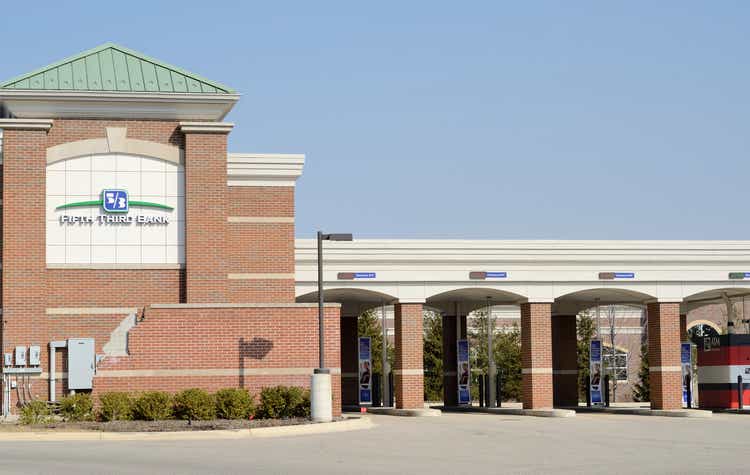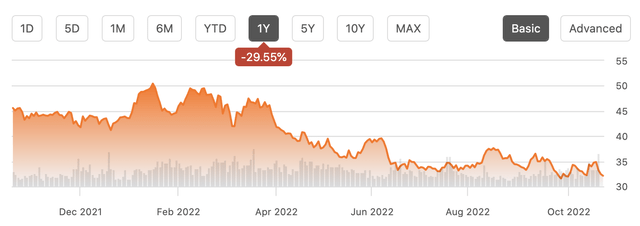RiverNorthPhotography
Shares of Fifth Third Bancorp (NASDAQ:FITB) dropped over 4% in response to Q3 earnings that missed expectations. The bank is seeing some cost pressures, and its deposit performance was particularly disappointing, which threatens to be a headwind to net interest margin (NIM) accretion going forward. With shares trading about 1.5x adjusted tangible book value, I see better value elsewhere in the regional space and do not expect shares to meaningfully recover their 2022 losses.
In the company’s third quarter, it earned adjusted EPS of $0.93. This missed expectations by about $0.05. The company did generate a return on equity of 15.3%, so like essentially all of the banks who reported earnings, on an absolute basis, the company is doing well. After years of living under low interest rates, banks are finally benefiting from rising rates with significant gains to net interest income. Fifth Third was no exception to this.
In the quarter, it earned a NIM of 3.22%, which was up 30bp sequentially and 63bp from a year ago. Combined with modest asset growth, this led to net interest income growth of 12% sequentially to $1.5 billion. On contributions to the change in NIM, its assets benefited by 0.32% while funding costs were a 0.06% drag.
Loans rose 2% to $119.6 billion with strength on the commercial side, though this growth was a bit slower than peers. On the secured consumer side, the business actually saw loans decline by $200 million to $16.8 billion. While a small part of the portfolio, it was also surprising to see period-end credit card balance hold flat at $1.8 billion. Credit card balances have been strongly rising nationwide, so I would have expected to see some growth here. On the positive side, the rate on Fifth Third’s loan book rose by 58bp, given most of its loans are floating rate.
Noninterest income was down 1% to $727 million on lower deposit fees. In April, it announced an end to minimum balance fees, and this headwind is now being fully felt in financials. At the same time, noninterest expenses rose 5% due to 4% compensation inflation as FITB raised its minimum wage to $20 an hour.
Fifth Third’s fee reduction on its deposit business is particularly interesting as we contemplate how the bank is trying to compete to retain funds. With consumers savings declining and the Fed reducing its balance sheet, deposits face headwinds. As they offer the lowest-cost, most stable type of funding, retaining the bulk of deposits is important to maintain solid NIM margins. Here, Fifth Third’s performance was disappointing. Its deposit base declined by 3% to $157.2 billion. Now, some banks that believe they have excess deposits, like Comerica (CMA) have essentially been letting deposits leave by being particularly stingy on how much of the Fed’s higher rates they pass on to depositors. I do not particularly care for this strategy as I would rather see deposit retentions to ensure medium-term funding stability, but it is an active choice. Unfortunately, it does not seem FITB is making this choice as it raised its deposit substantially from 0.09% to 0.41% (Comerica for comparison went to 0.20%).
FITB is passing on more of the Fed’s rate hikes than most peers, and yet its deposits are falling more sharply. This suggests it is losing market share vs peers and is facing a competitive environment for deposits. If it was a management choice, that could quickly be solved by pushing up deposits rates, but more appears to be going on here. Combined with slow loan growth, and FITB appears to be facing a particularly competitive environment for its business. This creates risk for its ability to retain margins and grow assets.
Because of declining deposits, its securities portfolio shrank by $700 million to $63.5 billion. This fall was driven by a sizable decline in cash & equivalents. The yield on its portfolio rose by a modest 13bp to 2.86%. Unlike its loan book, its securities portfolio is largely fixed rate, so it only benefits from higher rates gradually as it reinvests maturities into higher-yielding securities. The portfolio has a 5.5 year duration, so it will be a prolonged period of slow interest increases.
On the credit side, FITB is handling the slowdown in economic activity well. Provisions for credit losses were $147 million down from $168 million last quarter. Over the past three months, nonperforming loans declined by 1bp to 0.46% of all loans. The company’s allowance for credit losses totals 1.91% of loans. This provides a sufficient buffer for more loans to fall delinquent. Unless there is a meaningful recession, its $150-200 million quarterly provisioning run-rate appears sufficient.
During the quarter, FITB also built capital. Its CET1 ratio is now 9.1% from 8.95% in Q2, and it is targeting 9.25% at year end. The company offers a secure 4% dividend yield, but I would not expect significant buybacks until capital rises further, likely sometime in 2023, depending on economic conditions. When looking at valuation, it is important to remember to exclude unrealized gains or losses in its held-to-maturity investment portfolio, which have led to -$5.3 billion in accumulated other comprehensive income. Tangible book value ex AOCI is $21.60.
In Q4, the bank expects loans to rise 1%, another sequential decline in the growth rate. The competitive pressures that weighed on Q3 results do not appear to be abating. Thanks to higher rates, net interest income should rise by about 5%, though this also represents a significant slowing from Q3, likely as the banks feels a bit more pressure on the funding side.
With some margin pressure and questions over its trajectory of deposits, the company may show less earnings upside than peers that have built deposits like Citizens Financial (CFG) or at least retaining more deposits more easily, like Truist (TFC). With credit provisions likely at a more sustainable rate now, I would expect EPS to remain in the $0.90-$0.95 area. This leave shares 9x earnings. I do see risk skewed a bit to the downside if deposit performance deteriorates further. With most regional banks trading at a single-digit P/E, at 1.5x tangible book and facing more competitive pressures, FITB is relatively unattractive, and I would rather own banks more clearly poised to benefit from higher rates like CFG. I would expect FITB To remain in the $30-$35 area until there is evidence of operating performance improvement.



Be the first to comment